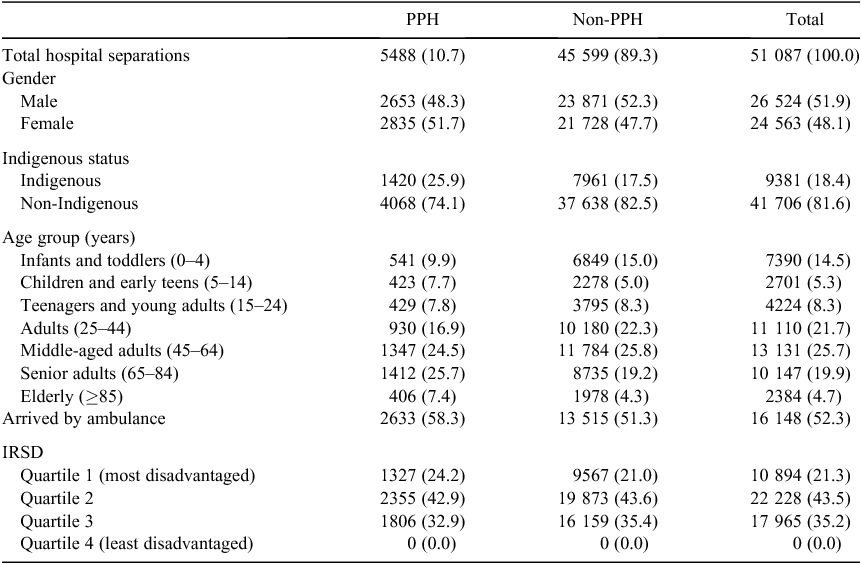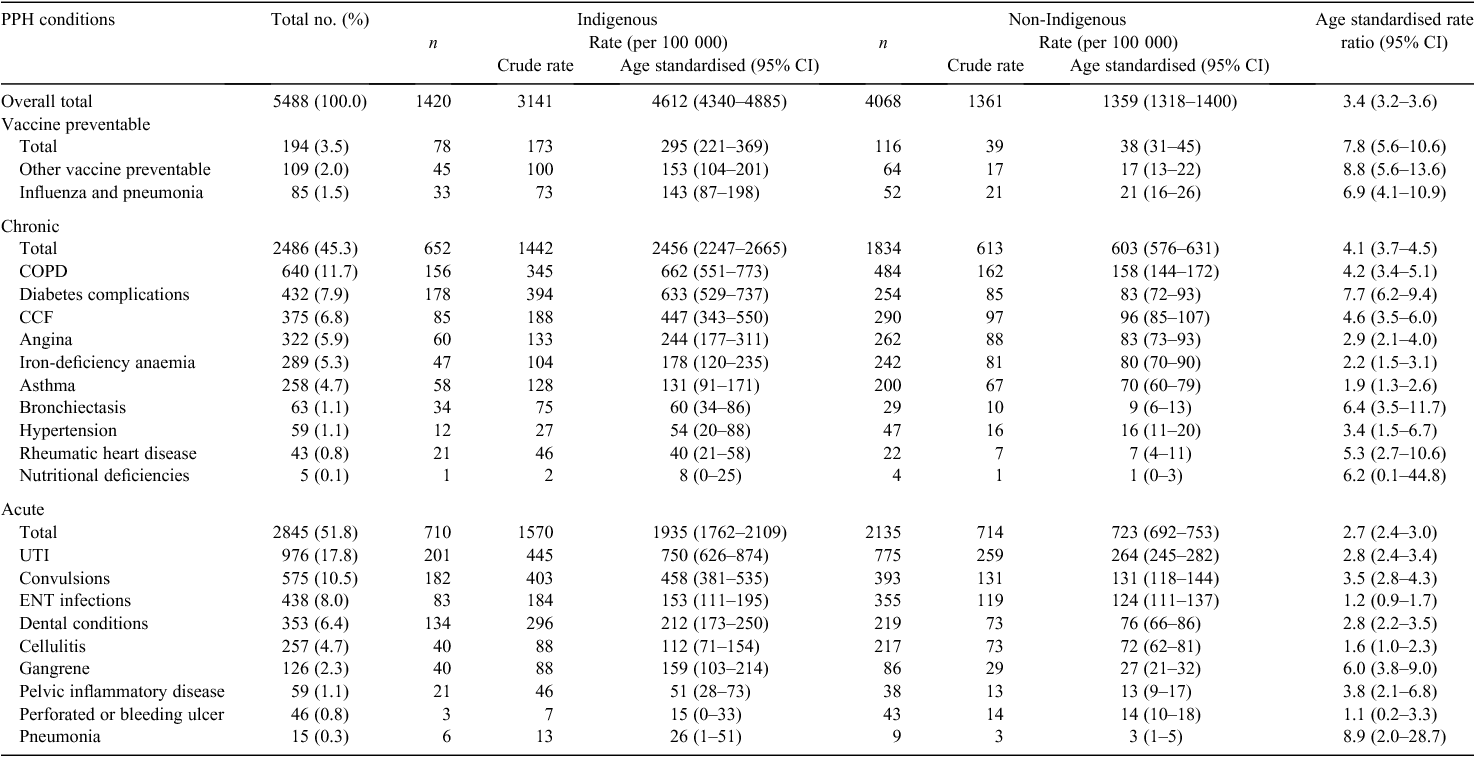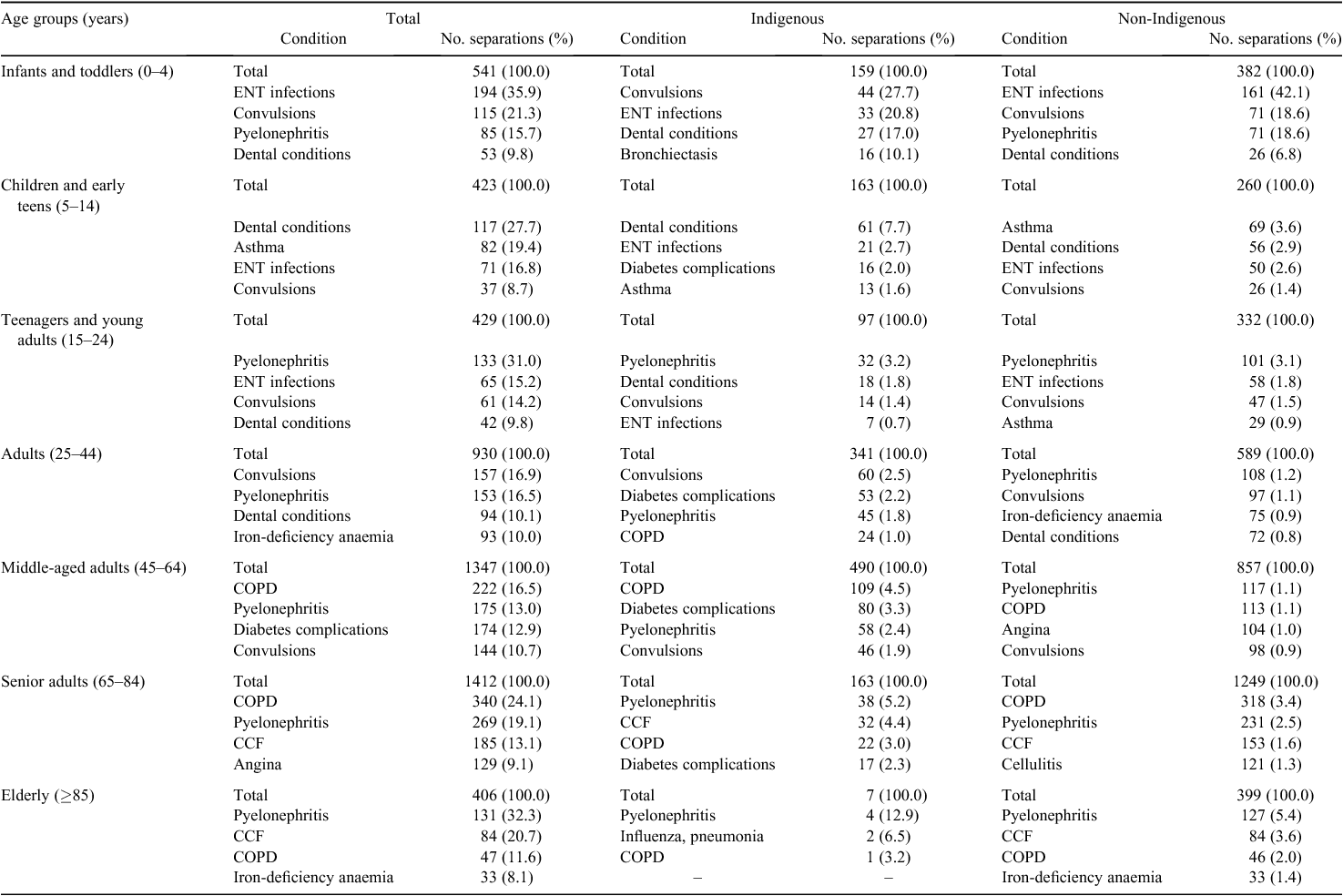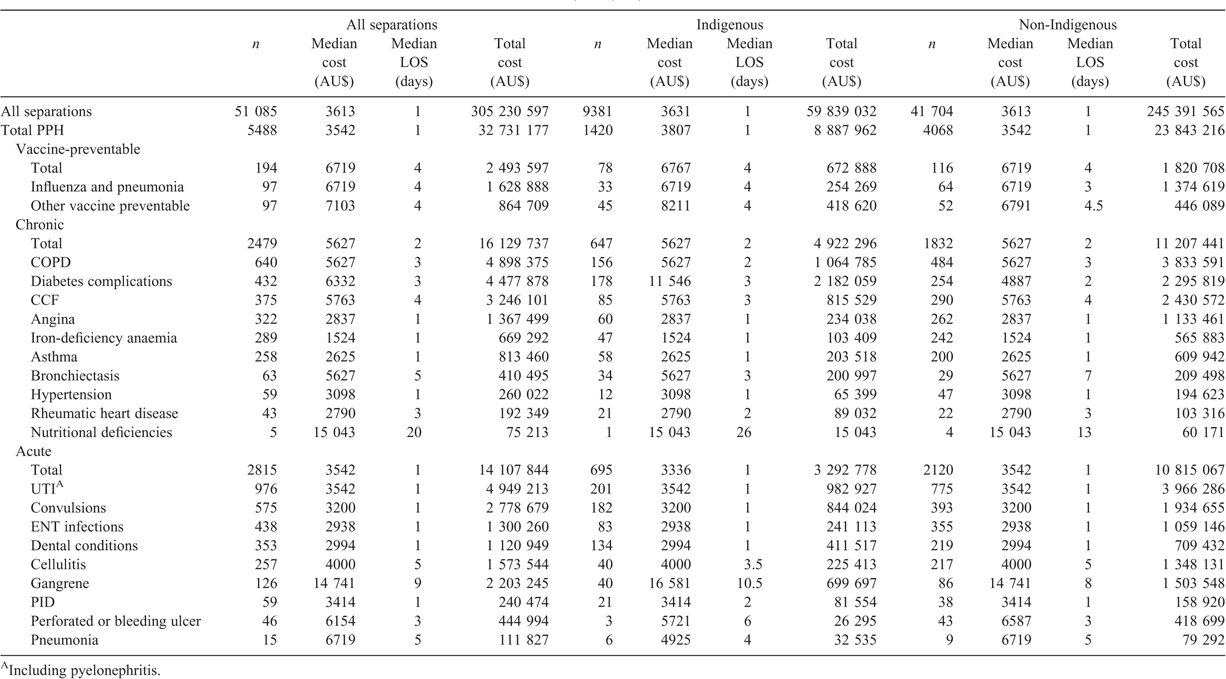Preventable hospitalisations in regional Queensland: potential for primary health?
Linton R. Harriss A D , Fintan Thompson A , Kenny Lawson C , Mary O'Loughlin A and Robyn McDermott A BA James Cook University, Australian Institute of Tropical Health and Medicine, College of Public Health, Medical and Veterinary Sciences, Centre for Chronic Disease Prevention, PO Box 6811, Cairns, Qld, 4870 Australia. Email: fintan.thompson@jcu.edu.au; mary.oloughlin@my.jcu.edu.au; robyn.mcdermott@jcu.edu.au
B University of South Australia, Sansom Institute for Health Research, Centre for Population Health Research, City West Campus, Adelaide, SA, 5000 Australia.
C Translational Health Research Institute (THRI), School of Medicine, Western Sydney University, Locked Bag 1797, Penrith NSW, 2751, Australia. Email: K.Lawson@westernsydney.edu.au
D Corresponding author. Email: linton.harriss@jcu.edu.au
Australian Health Review 43(4) 371-381 https://doi.org/10.1071/AH18033
Submitted: 1 August 2017 Accepted: 17 April 2018 Published: 3 August 2018
Journal Compilation © AHHA 2019 Open Access CC BY-NC-ND
Abstract
Objective The aims of this study were to: (1) use local health data to examine potentially preventable hospitalisations (PPHs) as a proportion of total hospital separations and estimated costs to a large regional hospital in northern Queensland, including differences associated with Indigenous status; and (2) identify priority conditions and discuss issues related to strategic local primary health intervention.
Methods A cross-sectional analysis was conducted using Queensland Hospital Admitted Patient Data Collection data (July 2012–June 2014) restricted to 51 087 separations generated by 29 485 local residents. PPHs were identified from the International Statistical Classification of Diseases and Related Health Problems 10th Revision Australian Modification (ICD-10-AM) and procedure codes using National Healthcare Agreement definitions. Age-standardised separation rates were calculated using Australian 2001 reference population and associated economic costs were estimated using Australian-refined diagnosis related groups.
Results Eleven per cent (n = 5488) of all hospital separations were classified as PPH, and most were for common chronic (n = 2486; 45.3%) and acute (n = 2845; 51.8%) conditions. Because many acute presentations reflect chronic underlying disease, chronic conditions account for up to 76.5% of all PPHs. Age-standardised PPH rates were 3.4-fold higher for Indigenous than non-Indigenous people. Associated 2-year costs were AU$32.7 million, which was 10.7% of estimated total health care expenditure for hospital separations, and were higher for Indigenous (14.9%) than non-Indigenous (9.7%) people.
Conclusions High hospitalisation rates and costs for common preventable chronic conditions represent opportunities for primary healthcare interventions. In particular, community-level health services need to be more responsive to the needs of local Indigenous families.
What is known about the topic? PPH rates are used as a measure of timely access to quality primary health care, and are incrementally higher in regional and remote areas than in major cities. Investment in primary healthcare services has been shown to significantly reduce costs associated with avoidable hospitalisations.
What does this paper add? This study used local health data to identify the most common PPH conditions presenting to a large regional hospital in northern Queensland, including estimation of costs and differences associated with Indigenous status. Recommendations are made to strengthen primary healthcare and reduce hospital-related costs.
What are the implications for practitioners? Interventions to address high PPH rates should be tailored to meet the needs of the local population. Primary health strategies targeting common chronic conditions provide the greatest opportunity to reduce avoidable hospitalisations and costs in this regional area. Investment in collaborative, evidence-based interventions is recommended and justified, especially for Indigenous Australians.
Additional keywords: Aboriginal and Torres Strait Islander, chronic disease, health economics, potentially preventable hospitalisation, primary health care.
Introduction
Regional and remote hospitals have high rates of admission for conditions that should have been managed with timely access to quality primary and community health services.1,2 Australia’s National Healthcare Agreement defines these admissions as potentially preventable hospitalisations (PPHs).3 Although debate remains around PPH definitions,4 the Australian Institute of Health and Welfare (AIHW) routinely collects and analyses PPH data (sourced from hospital separation diagnosis and procedure codes) as a component of the National Health Performance Framework to monitor the quality and effectiveness of these services.
The PPH data are broadly classified into three types of conditions: vaccine preventable, chronic health and acute medical. The most recent AIHW report for 2014–15 found 493 347 PPHs were recorded in Australian public hospitals, accounting for 8.2% of all separations.5 Rates per 1000 population remain incrementally higher in regional (inner = 25.7; outer = 29.3) and remote areas (remote = 39.8; very remote = 59.1) than in major cities (23.7).5 The reason people living in regional and remote areas have higher PPH rates is a complex issue, but three factors are likely to contribute significantly: (1) higher levels of socioeconomic disadvantage;6,7 (2) difficulty accessing health services;8,9 and (3) a higher burden of disease and comorbidities.10–14
Since 2006, the Australian Health Ministers’ Advisory Council has produced biennial reports against the Aboriginal and Torres Strait Islander Health Performance Framework. Over this time period, results have remained fairly consistent despite various improvements to coding rules. The most recent of these reports15 found the rate of PPH for Aboriginal and Torres Strait Islander people is threefold higher than for non-Indigenous Australians, and this disparity generally increases with age and remoteness. The report indicates these rates likely reflect higher underlying disease burden, limited access to early detection and management of common chronic conditions and limited non-hospital alternatives in rural and remote areas.15 This is supported, in part, by a recent Northern Territory study of 14 184 people living in remote Indigenous communities over the period 2002–11,16 which found that higher primary healthcare utilisation was associated with a 60–85% reduction in common chronic PPH, and every AU$1 invested in primary health could produce savings of AU$3.95–11.75 in hospital costs, in addition to other health benefits for individuals.
The relative paucity of primary and other community health services in regional and remote areas contributes significantly to high PPH rates, with local hospitals becoming the default service provider.17 For example, factors such as adequate physician supply, long-term physician–patient relationships and general practitioner (GP) management plans have all been found to be important for reducing PPHs.18 A recent report from the Grattan Institute identified northern Queensland as a ‘hot spot’ for PPHs, with rates at least 50% higher than the state average in every year for a decade.19 The authors of that report recommend that geographical areas such as these represent persistent and costly health inequality, and should be prioritised for state and federal government investment to improve primary and other health services. The authors also recommend using local data to assist in identifying the health priorities of local communities and in developing, testing and evaluating tailored interventions over time.19 The federal government is currently trialling the introduction of ‘health care homes’ throughout Australia,20 the purpose of which is to strengthen the role of general practices and Aboriginal Community Controlled Health Services (ACCHSs) as the central care provider (rather than the hospital) by providing continuity of care for people with chronic and complex conditions. In addition to improvements in access, care processes and patient experience, it is hoped that this initiative will reduce unnecessary hospitalisations, including PPHs.
The purpose of the present study was to use local admissions data from a large regional tertiary care hospital in far north Queensland to examine PPHs (and estimated costs) as a proportion of total hospital separations and by Indigenous status. We also identify opportunities for local primary health services to reduce hospitalisations and discuss issues related to strategic intervention.
Methods
Study setting and population
Located in northern Queensland, Australia, the large public hospital provides tertiary care for over 275 000 people. Although the hospital services people living in very remote areas, it primarily caters for the large regional population in the surrounding 10 Statistical Local Areas (SLAs). Approximately 68 867 hospital separations were recorded between 1 July 2012 and 30 June 2014. Of these, 74.2% (51 087) were generated by people living in the 10 SLAs, and the results of the present study are based on these separations. The 10 SLAs ‘map’ to two larger Local Government Area (LGA) boundaries (Cairns (LGA/32070) and Yarrabah (LGA37600)). The Far North Queensland Human Research Ethics Committee approved the present study (HREC/13/QCH/131-880) and data were provided by Queensland Health.
Demographic and other factors of interest
Factors of interest were determined from raw Queensland Hospital Admitted Patient Data Collection (QHAPDC) data, including gender, age, Indigenous status, SLA, medical or unit record number (URN), length of stay (LOS), admission and discharge dates and final primary and secondary diagnoses. Socioeconomic disadvantage for each SLA was measured using the Index of Relative Socioeconomic Disadvantage (IRSD) calculated by the Australian Bureau of Statistics21 and based on 2011 Census data (http://www.abs.gov.au/AUSSTATS/abs@.nsf/DetailsPage/2033.0.55.0012011?OpenDocument, accessed 4 February 2018). The IRSD was used because it provides a broad measure of disadvantage by ranking areas according to a range of social and economic conditions reported at the individual and household level within each SLA. Some of the factors of interest when measuring IRSD include income, educational attainment, unemployment and unskilled occupations. Lower IRSD scores indicate areas with greater disadvantage and higher scores indicate areas with least disadvantage.
Potentially preventable hospitalisations
PPHs were identified from discharge diagnosis codes using International Statistical Classification of Diseases and Related Health Problems 10th Revision Australian Modification (ICD-10-AM)22 and relevant procedure codes using National Healthcare Agreement definitions.23
Estimation of costs
Costs associated with PPHs were estimated using Australian-refined diagnosis-related groups (AR-DRG). The AR-DRGs are sourced from the AIHW National Hospital Morbidity Database (NHMD) with diagnostic groupings based upon ICD-10-AM classifications. According to the AIHW, AR-DRG is an Australian admitted patient classification system that provides a clinically meaningful way of relating patient casemix to resources required by the hospital.24 National average costs for each AR-DRG were provided by the Independent Hospital Pricing Authority (IHPA), including both total cost and disaggregated into main procedures and average LOS. This study selected costs relating to the financial year 2013–14 in order to align with the hospital’s admission data.25 These national average total costs for AR-DRGs were then converted into an ‘average per day cost’ by dividing the total cost by average LOS. To estimate hospital costs, this average per day cost was multiplied by the actual LOS taken from hospital records for each acute PPH patient admission. Total costs for each PPH and median patient cost, driven by LOS, were estimated.
Statistical analysis
Analyses were performed with STATA 13.1 (StataCorp, College Station, TX, USA). Records were linked to individuals using the unique URN and the number of separations per person was calculated as the number of separations per URN.
Crude rates per 100 000 population were calculated using two financial years of hospital separation data combined (1 July 2012–30 June 2014) and two financial years of population data for the same period. A 2-year period of hospitalisations was selected to reduce the effect of annual variability in separation rates. The population data were the estimated residential population sourced from the Queensland Regional Database maintained by the Queensland Government Statistician’s Office (http://www.qgso.qld.gov.au/products/tables/qld-regional-database/index.php; accessed 15 April 2015). Data were extracted in 5-year age groups by Indigenous status for Cairns (LGA/32070) and Yarrabah (LGA37600).
Age distributions for Indigenous and non-Indigenous separations were dissimilar. To enable comparisons of separation rates between groups, crude rates were directly age standardised26 to the 30 June 2001 Australian standard population maintained by Australian Bureau of Statistics.27
Each hospitalisation in the dataset had an allocated diagnosis-related group (DRG). To estimate the cost of PPHs, each hospitalisation was allocated a monetary figure based on the corresponding DRG. These amounts were then aggregated based on PPH categories and the total and median costs were calculated by Indigenous status.
Results
Potentially preventable hospitalisations
In the two financial years 2012–14, there were approximately 51 087 separations generated by 29 485 people (Table 1). Of these separations, 10.7% (5488) were classified as potentially preventable. Half of all PPHs were for women (51.7%) and approximately one-third were for those aged ≥65 years (33.1%). Indigenous people represented 25.9% of all PPHs despite accounting for only 12.9% of the Cairns and Yarrabah LGA populations. Potentially preventable hospitalisation rates were substantially higher for Indigenous people across 5-year age groups, particularly in older age groups (Fig. 1).
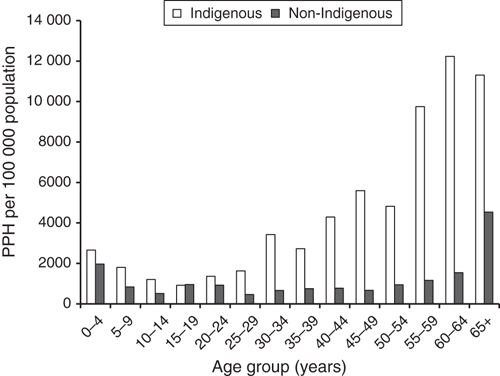
|
Most PPHs were for chronic (45.3%) and acute (51.8%) conditions (Table 2). Most chronic conditions (93.2%) were for chronic obstructive pulmonary disease (COPD; n = 640; 25.7%), diabetes complications (n = 432; 17.4%), congestive cardiac failure (CCF; n = 375; 15.1%), angina (n = 322; 13.0%), iron-deficiency anaemia (n = 289; 11.6%) and asthma (n = 258l; 10.4%). Most acute conditions (95.8%) were for urinary tract infections (UTI; n = 976; 34.3%), convulsions (n = 575; 20.2%), ear, nose, throat (ENT) infections (n = 438; 15.4%), dental conditions (n = 353; 12.4%), cellulitis (n = 257; 9.0%) and gangrene (n = 126; 4.4%).
The top four conditions for Indigenous people were UTIs (n = 201; 14.2%), convulsions (n = 182; 12.8%), diabetes complications (n = 178; 12.5%) and COPD (n = 156; 11.0%). The top four conditions for non-Indigenous people were UTIs (n = 775; 19.1%), COPD (n = 484; 11.9%), convulsions (n = 393; 9.7%) and ENT infections (n = 355; 8.7%).
Age-standardised rate ratios
Age-standardised PPH rates were higher for Indigenous people across all PPH categories (Table 2). Overall, Indigenous people were 3.5-fold more likely to have a PPH than non-Indigenous people (age-standardised rate 3.4; 95% confidence interval (CI) 3.2–3.6). Age-standardised rates for Indigenous people were eightfold higher for vaccine-preventable PPHs (7.8; 95% CI 5.6–10.6)], fourfold higher for chronic PPH (4.1; 95% CI 3.7–4.5), almost threefold higher for acute PPH (2.7; 95% CI 2.4–3.0) and nearly eightfold higher for diabetes complications (7.7; 95% CI 6.2–9.4).
Age groups
Acute conditions were highest among younger age groups and generally decreased with age, whereas chronic conditions were lowest among younger age groups and increased with age. Vaccine-preventable conditions were fairly uniform across age groups. The pattern of PPH distribution across the lifespan was similar by Indigenous status except that the intersection point where chronic conditions start to outnumber acute conditions occurred one decade earlier for Indigenous people (41–50 years) than non-Indigenous people (51–60 years; Fig. 2). Diabetes complications appeared regularly in the top four PPH conditions across the lifespan for Indigenous people and COPD appeared at a younger age (Table 3).
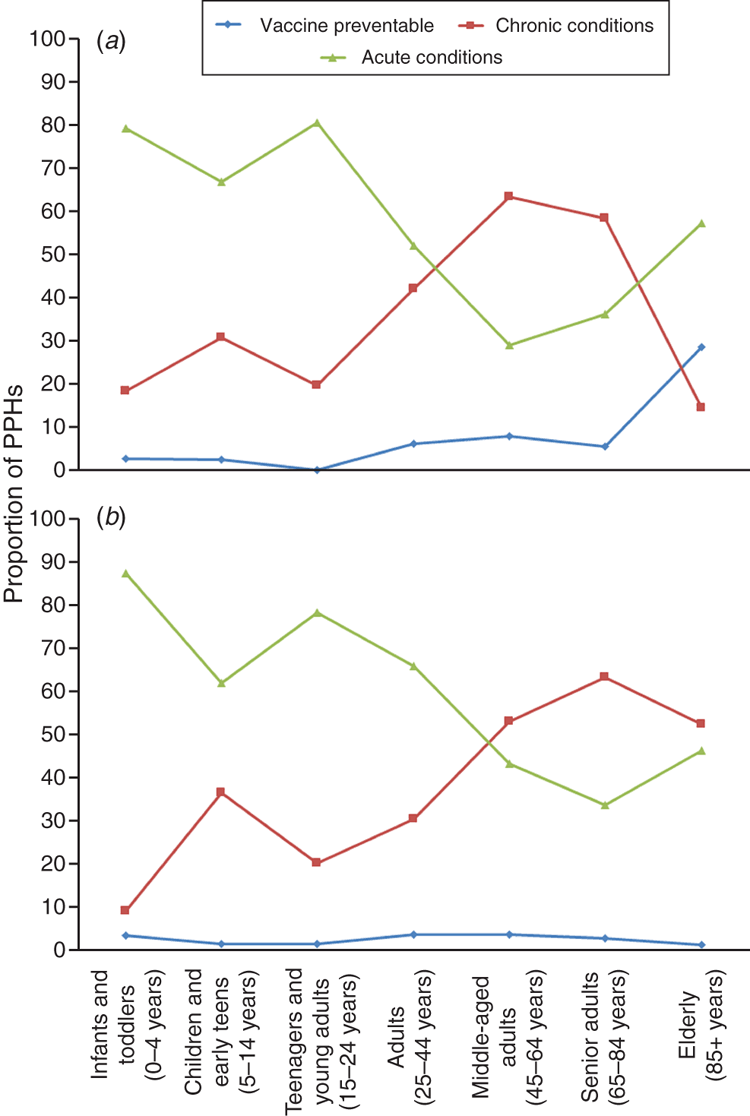
|
Costs of PPH
All separations
Total PPH represented 5488 separations and an estimated AU$32.7 million, which was 10.7% of total hospital separation expenditure over the 2-year period (Table 4). The top three most expensive PPHs, in terms of total cost for all separations, were UTI (AU$4.9 million), COPD (AU$4.9 million) and diabetes (AU$4.5 million). Associated median costs (and median LOS) per separation types were: AU$3542 (1 day) for UTI, AU$5627 (3 days) for COPD and AU$6332 (3 days) for diabetes.
Non-Indigenous separations
Total PPHs in the non-Indigenous population represented 4068 separations and AU$23.8 million, which was 9.7% of total hospital costs for this group. The top three most expensive PPHs, in terms of total cost for all separations, were UTI ($4.0 million), COPD ($3.8 million) and CCF ($2.4 million).
Indigenous separations
Total PPHs in the Indigenous population represented 1420 separations and AU$8.9 million, which was 14.9% of total hospital costs for this group. The top three most expensive PPHs, in terms of total cost for all separations, were diabetes ($2.2 million), COPD ($1.1 million) and UTI ($1 million). Overall, the median cost per separation type tended to be slightly higher for Indigenous people, with diabetes the most notable with a median cost (LOS) of AU$11 546 (3 days) for Indigenous people compared with AU$4887 (2 days) for non-Indigenous people.
Discussion
Chronic and acute conditions accounted for 97% of all PPHs to this large public hospital in regional north Queensland. Most chronic conditions were for COPD, diabetes complications, CCF, angina, iron-deficiency anaemia and asthma. Most acute PPH conditions were for UTIs, convulsions, ENT infections, dental conditions, cellulitis and gangrene. Although UTIs, dental conditions, cellulitis and gangrene present acutely, they often reflect a chronic underlying condition, such as diabetes. If this was taken into consideration, chronic conditions would account for 76.5% of all PPHs. Age-standardised rates for Indigenous people were consistently higher than those for non-Indigenous people, with diabetes complications appearing regularly in the top four PPH conditions across the lifespan and chronic conditions such as COPD appearing at a younger age. The financial costs associated with PPH were substantially higher for Indigenous people, and justify investment in strategic, collaborative, evidence-based primary health interventions aimed at addressing health inequalities experienced in northern Queensland.
PPH rates were found to be consistently higher for Indigenous people across the lifespan. These findings are consistent with a recent national report against the Aboriginal and Torres Strait Islander Health Performance Framework28 that found these disparities also generally increased with remoteness. A recent Northern Territory study29 found PPH rates per 100 000 population were 11 090 for Aboriginal people and 2779 for non-Aboriginal people for the 8-year period from 1998–99 to 2005–06. These rates are somewhat higher than those observed in the present study, but the Northern Territory study was based on hospitalisation data for the entire Northern Territory covering large areas considered to be remote or very remote, and remoteness has been shown to be consistently associated with higher PPH rates.5 We attempted to remove these geographical differences by restricting the present study to only those people considered local residents surrounding the hospital. Although we observed relatively low rates of vaccine-preventable PPHs in our population, the rate of these PPHs for Indigenous people was nearly eightfold higher than for non-Indigenous people. This is consistent with national reports.5 Aboriginal Medical Services and other health services in the area have invested considerable effort in recent years to improve historically low vaccination rates. In addition to existing clinic-based vaccination, services have engaged in strategies including education programs, outreach home visits and targeting of priority groups within the community.
Aspects of primary healthcare that have been found to be important for reducing PPH include adequate physician supply, continuity of care, GP management plans, subsidised community health services and higher utilisation.2,16,30 A recent preliminary report released for consultation on primary care services funded through the Medicare Benefits Schedule found that funding for urgent after-hours services in Queensland is far less in regional and remote areas like Far North Queensland than urban areas such as Brisbane.31 Although there appears to be broad agreement that these types of services may increase access to primary healthcare, their role in reducing PPH is currently undetermined. Indeed, considerable concern exists among professional groups that these services may undermine the quality and safety of primary health through the provision of costly and fragmented care often by underqualified medical practitioners.31–33
Four recent publications have reviewed available evidence regarding primary health interventions and PPH, most of which has been focused on chronic disease-specific approaches (e.g. diabetes and COPD).2,18,30,34 Overall, evidence for specific interventions to reduce PPHs is weak. Australian initiatives show promise rather than conclusive evidence.30 The international review of 49 reports from high-income countries concluded that strong primary care (adequate primary care physician supply and continuity of care embodied in the ‘medical home’ approach, including self-management support as described in the Wagner Chronic Care Model35) reduces avoidable hospitalisations for chronic conditions.18 The authors of that review also found that there is currently a lack of evidence for other interventions, such as disease-specific management programs. Although there are numerous examples of care coordination programs in Australia, their effect on reducing PPH rates is inconclusive and requires further investigation.2 A recent report from the Grattan Institute identifying ‘hot spots’ with persistently high PPH rates recommends developing, testing and evaluating tailored interventions for local areas to address the health inequities that lead to higher PPH rates.19 The authors of that report include a collaborative approach in their strategy, whereby primary health networks are supported financially and otherwise by federal and state governments to lead targeted intervention research with primary and other health services within their jurisdiction. However, the federal government currently funds primary healthcare and the state governments fund hospital care. Consequently, there are likely to be considerable financial challenges ahead in achieving the strategic development (and sustained financing) of the innovative interventions required.
The present study has identified opportunities to reduce PPHs in this large regional hospital in northern Queensland. We found that 76.5% of all PPHs were either chronic conditions (COPD, diabetes complications, CCF, angina, iron-deficiency anaemia and asthma) or likely related acute conditions such as UTIs, dental conditions, cellulitis and gangrene. As such, we suggest targeting these specific conditions because they are likely to be conducive to trials involving collaborative primary healthcare interventions and potentially deliver the most cost savings and individual benefit. One-third of all PPHs in the present study were for people aged ≥65 years. Targeting programs at high-risk age groups is therefore justified. Several promising projects are currently underway in the region aiming to improve the integration of care for elderly people living with complex conditions. The local region is not without other strategies to address conditions favourable to primary healthcare management, although historically many of these strategies have been implemented without proper consideration for effective evaluation. The local public hospital currently provides a suite of services that have been shown to reduce PPH for specific conditions,19 including a specialist diabetes out-patient clinic, physiotherapy and rehabilitation clinics for cardiac and pulmonary conditions and nurse-led case management of people with complex health needs. Initiatives such as the integrated electronic medical record and telehealth have also been evolving to enhance access, communication and continuity of care between health services. However, the results of the present study indicate that more could be done, especially for Aboriginal and Torres Strait Islander people living in the region.
Initiatives to reduce PPHs specifically for Indigenous people are still rare.30 Much of the work is performed by the local Aboriginal Medical Services using Medicare Item 715 as remuneration for annual health checks.36 These are designed to promote early detection, diagnosis and management of many conditions associated with PPHs. There are also specific remuneration arrangements for GP management plans for chronic diseases. Aboriginal Medical Services also initiate programs targeting areas of high community need, although these are often challenging for the organisation to fund and resource. These initiatives may target specific health issues such as influenza vaccination, diabetes, oral health and sexually transmissible infections, or be focused on broader upstream issues such as maternal and child health, social and emotional well-being and alcohol and drug support. Future success in lowering PPH rates is likely to involve collaborative design and implementation of multifactorial programs targeting the common conditions and high-risk subgroups with complex needs identified in the present study. Programs should include: (1) early detection, early treatment and symptom management; (2) creation of supportive environments; (3) self-management support; (4) service delivery and coordination; (5) local liveability; (6) socioeconomic opportunity;37,38 and (7) respectful, community-led collaboration.39
Key to lowering PPH rates in northern Queensland is likely to be further development of primary healthcare services, including Aboriginal Medical Services. A promising reform in this area is the federal government’s introduction of ‘health care homes’ throughout Australia. Clinicians from participating primary healthcare services will become responsible for the overall coordination of chronic disease management of their patients, regardless of where the treatment occurs.20,40 In exchange for this, practices will receive an annual complexity-based payment of between AU$591 and AU$1795 per patient, and a single grant to support training and establishment.20 Whether this model will work in rural and remote areas is yet to be seen. Evidence from implementation studies of the Medical Home in the US has demonstrated some improvement in preventative care service delivery for people with chronic conditions, although results are mixed and insufficient for service provision (including accessibility and coordination of care), clinical outcomes, in-patient utilisation41 and patient experience.42 Diversity in the primary care setting has challenged implementation of the Medical Home care model, indicating a need for setting-specific approaches to address the healthcare needs of distinctive population subgroups.
The present study has numerous strengths and also limitations. Analysis was based on a 2-year QHAPDC dataset for the major regional public hospital servicing a discrete area in northern Queensland. The dataset was complete and analysis was carefully restricted to local residents living in 10 SLAs surrounding the hospital. However, the results are subject to error inherent in any secondary administrative dataset. For example, errors in defining the local population within SLAs immediately around the hospital may have occurred from incorrect information collected relating to residential postcode and suburb. Similarly, PPHs used in our analyses were defined using National Healthcare Agreement definitions.23 These include relevant ICD-10-AM discharge diagnosis and procedure codes, both of which have been shown to have limited accuracy.43,44
Some controversy exists as to whether current PPH conditions truly reflect hospitalisations that are potentially preventable. As such, PPH definitions are frequently revised and are recommended to be used as performance indicators only.4 In addition, accuracy in identifying Indigenous status in Australian public hospitals has been shown to vary by geographical location, with only 93% of Indigenous and 98% of non-Indigenous separations correctly identified in outer regional settings such as ours.45 Consequently, the true number of Indigenous separations in our dataset and age-standardised estimates are likely to be higher than reported here. The costing analysis was essentially a ‘top-down’ approach using national average costs for AR-DRG and applying to the hospital by adjusting for actual LOS. This is appropriate for analysis at a population level. However, the costs are approximations. A more refined method would be, for example, a microcosting approach to directly access the hospital’s medical and financial records to cost each acute admission. However, this approach was not practicable, nor deemed necessary, for this population-level analysis.
Conclusion
The results of the present study suggest that opportunities exist to improve local hospital and primary health services to reduce hospitalisation for common preventable conditions in regional north Queensland. In particular, community-level health services need to be more responsive to the needs of local Indigenous families. Future research should be visionary and committed to improvements over the long term. Initiatives need to involve formal coordinated collaboration between primary health networks, Queensland Health and ACCHSs supported by secure funding and other resources from federal and state governments. Trialling and prospective evaluation of these initiatives would provide timely evidence regarding efficiency and cost-effectiveness for both local and national use.
Competing interests
The authors declare they have no competing interests.
Acknowledgements
The Centre for Chronic Disease Prevention thanks all who participated in the data extraction process in Queensland Health, Cairns. In particular, the authors acknowledge Kate Heath, Kim Mahoney and Kathy Small. The authors recognise that the commitment to this process was significant and, in many cases, done on top of an already hectic workload and with no financial recompense. The authors hope the information collected through this process provides valuable information that can be used at a local and state level. The Centre for Chronic Disease Prevention receives funding from the Department of Health, Queensland, and includes the Centre for Research Excellence: Prevention of Chronic Conditions in Rural and Remote High-Risk Populations. The research reported in this manuscript is partly a project of the Australian Primary Health Care Research Institute, which is supported by a grant from the Australian Government Department of Health, under the Primary Health Care Research, Evaluation and Development Strategy. The information and opinions contained in it do not necessarily reflect the views or policy of the Australian Primary Health Care Research Institute or the Australian Government Department of Health.
References
[1] National Health Performance Authority (NHPA). Healthy communities: potentially preventable hospitalisations in 2013–14. Sydney: NHPA; 2015.[2] Clinical Epidemiology and Health Service Evaluation Unit (CEHSU). Potentially preventable hospitalisations: a review of the literature and Australian policies. Final report. Melbourne: CEHSU, Melbourne Health, The Royal Melbourne Hospital; 2009.
[3] Australian Institute of Health and Welfare. National healthcare agreement (2017). 2017. Available at: http://meteor.aihw.gov.au/content/index.phtml/itemId/629963 [verified 15 March 2017].
[4] Page A, Ambrose S, Glover J, Hetzel D. Atlas of avoidable hospitalisations in Australia: ambulatory care-sensitive conditions. Adelaide: University of Adelaide, Public Health Information Development Unit; 2007.
[5] Australian Institute of Health and Welfare (AIHW). Admitted patient care 2014–15: Australian hospital statistics. Canberra: AIHW; 2016.
[6] Turrell G, Stanley L, de Looper M, Oldenburg B. Health inequalities in Australia: morbidity, health behaviours, risk factors and health service use. Canberra: Queensland University of Technology and the Australian Institute of Health and Welfare; 2006.
[7] Brameld KJ, Holman CDAJ. Demographic factors as predictors for hospital admission in patients with chronic disease. Aust N Z J Public Health 2006; 30 562–6.
| Demographic factors as predictors for hospital admission in patients with chronic disease.Crossref | GoogleScholarGoogle Scholar |
[8] Australian Institute of Health and Welfare (AIHW). Rural, regional and remote health: indicators of health status and determinants of health. Canberra: AIHW; 2008.
[9] Penchansky R, Thomas JW. The concept of access: definition and relationship to consumer satisfaction. Med Care 1981; 19 127–40.
| The concept of access: definition and relationship to consumer satisfaction.Crossref | GoogleScholarGoogle Scholar |
[10] Begg S, Vos T, Barker B, Stevenson C, Stanley L, Lopez AD. The burden of disease and injury in Australia 2003. PHE 82. Canberra: Australian Institute of Health and Welfare; 2007.
[11] Ahern MM, Hendryx M. Avoidable hospitalizations for diabetes: comorbidity risks. Dis Manag 2007; 10 347–55.
| Avoidable hospitalizations for diabetes: comorbidity risks.Crossref | GoogleScholarGoogle Scholar |
[12] Australian Institute of Health and Welfare (AIHW). The health and welfare of Australia’s Aboriginal and Torres Strait Islander peoples 2015. Canberra: AIHW; 2015.
[13] Australian Institute of Health and Welfare (AIHW). Aboriginal and Torres Strait Islander Health Performance Framework, 2008 report: detailed analyses. Canberra: AIHW; 2008.
[14] Harrold TC, Randall DA, Falster MO, Lujic S, Jorm LR. The contribution of geography to disparities in preventable hospitalisations between Indigenous and non-Indigenous Australians. PLoS ONE 2014; 9 e97892
[15] Australian Health Ministers’ Advisory Council (AHMAC). Aboriginal and Torres Strait Islander health performance framework 2017 report. Canberra: AHMAC; 2017.
[16] Zhao Y, Thomas SL, Guthridge SL, Wakerman J. Better health outcomes at lower costs: the benefits of primary care utilisation for chronic disease management in remote Indigenous communities in Australia’s Northern Territory. BMC Health Serv Res 2014; 14 463
| Better health outcomes at lower costs: the benefits of primary care utilisation for chronic disease management in remote Indigenous communities in Australia’s Northern Territory.Crossref | GoogleScholarGoogle Scholar |
[17] Standing Council on Health. National strategic framework for rural and remote health. Canberra: Commonwealth of Australia; 2012.
[18] van Loenen T, van den Berg MJ, Westert GP, Faber MJ. Organizational aspects of primary care related to avoidable hospitalization: a systematic review. Fam Pract 2014; 31 502–16.
| Organizational aspects of primary care related to avoidable hospitalization: a systematic review.Crossref | GoogleScholarGoogle Scholar |
[19] Duckett S, Griffiths K. Perils of place: identifying hotspots of health inequalities. Melbourne: Grattan Institute; 2016.
[20] Jackson CL, Hambleton SJ. Australia’s health care homes: laying the right foundations. Med J Aust 2017; 206 380–1.
| Australia’s health care homes: laying the right foundations.Crossref | GoogleScholarGoogle Scholar |
[21] Pink B. Technical paper. Socio-Economic Indexes for Areas (SEIFA). Canberra: Australian Bureau of Statistics; 2013. Available at: http://www.ausstats.abs.gov.au/Ausstats/subscriber.nsf/0/22CEDA8038AF7A0DCA257B3B00116E34/$File/2033.0.55.001%20seifa%202011% 20technical%20paper.pdf [verified 4 February 2018].
[22] Roberts RF, Innes KC, Walker SM. Introducing ICD-10-AM in Australian hospitals. Med J Aust 1998; 169 S32–5.
[23] Australian Institute of Health and Welfare. National healthcare agreement: PI 18-selected potentially preventable hospitalisations, 2015. 2015. Available at: http://meteor.aihw.gov.au/content/index.phtml/itemId/559032 [verified 15 July 2015].
[24] Australian Institute of Health and Welfare. Australian refined diagnosis-related groups (AR-DRG) data cubes. 2018. Available at: http://www.aihw.gov.au/hospitals-data/ar-drg-data-cubes/#ARDRGs [verified 4 July 2018].
[25] Independent Hospital Pricing Authority. National hospital cost data collection, public hospitals cost report, round 18 (financial year 2013–14). 2016. Available at: https://www.ihpa.gov.au/publications/australian-public-hospitals-cost-report-2013-2014-round-18 [verified 15 May 2017].
[26] Australian Institute of Health and Welfare. Methods and conventions. Age standardisation. In ‘Australia’s health 2014’. p. 504 2014. Available at: https://www.aihw.gov.au/reports/australias-health/australias-health-2014/contents/table-of-contents [verified 15 April 2015].
[27] Australian Bureau of Statistics (ABS). Standard population for use in age-standardisation. Canberra: ABS; 2011.
[28] Australian Health Ministers’ Advisory Council (AHMAC). Aboriginal and Torres Strait Islander health performance framework 2014 report. Canberra: AHMAC; 2015.
[29] Li SQ, Gray NJ, Guthridge SL, Pircher SLM. Avoidable hospitalisation in Aboriginal and non-Aboriginal people in the Northern Territory. Med J Aust 2009; 190 532–6.
[30] Katterl R. Anikeeva O, Butler C, Brown L, Smith B, Bywood P. Potentially avoidable hospitalisations in Australia: causes for hospitalisations and primary health care interventions. Primary Health Care Research & Information Service policy issue review. Adelaide: Primary Health Care Research & Information Service; 2012.
[31] Medicare Benefits Schedule Review Taskforce. Preliminary report for consultation. Urgent after-hours primary care services funded through the MBS. 2017. Available at: http://www.mbsreview.com.au/reports/after-hours-report_1.html [verified 15 June 2017].
[32] Royal Australian College of General Practitioners. After-hours home visiting services in primary healthcare. Position statement. 2016. Available at: https://www.racgp.org.au/download/Documents/Policies/Health%20systems/After-hours-position-statement.pdf [verified 15 October 2017].
[33] Royal Australian College of General Practitioners. RACGP calls for focus on patient safety in after-hours debate. [Media release] 2017. Available at: https://www.racgp.org.au/yourracgp/news/media-releases/racgp-calls-for-focus-on-patient-safety-in-after-hours-debate/ [verified 15 October 2017].
[34] Erny-Albrecht K, Oliver-Baxter J, Bywood P. Primary health care-based programmes targeting potentially avoidable hospitalisations in vulnerable groups with chronic disease. Primary Health Care Research & Information Service policy issue review. Adelaide: Primary Health Care Research & Information Service; 2016.
[35] Epping-Jordan JE, Pruitt SD, Bengoa R, Wagner EH. Improving the quality of health care for chronic conditions. Qual Saf Health Care 2004; 13 299–305.
| Improving the quality of health care for chronic conditions.Crossref | GoogleScholarGoogle Scholar |
[36] Australian Government Department of Health. Medicare health assessment for Aboriginal and Torres Strait Islander people (MBS Item 715). 2016. Available at: http://www.health.gov.au/internet/main/publishing.nsf/Content/mbsprimarycare_ATSI_MBSitem715 [verified 21 August 2017].
[37] Muenchberger H, Kendall E. Determinants of avoidable hospitalization in chronic disease: Development of a predictor matrix. Meadowbrook: Griffith University; 2008.
[38] Muenchberger H, Kendall E. Predictors of preventable hospitalization in chronic disease: priorities for change. J Public Health Policy 2010; 31 150–63.
| Predictors of preventable hospitalization in chronic disease: priorities for change.Crossref | GoogleScholarGoogle Scholar |
[39] Mikhailovich K, Morrison P, Arabena K. Evaluating Australian Indigenous community health promotion initiatives: a selective review. Rural Remote Health 2007; 7 746
[40] Primary Health Care Advisory Group. Better outcomes for people with chronic and complex health conditions. 2015. Available at: http://www.health.gov.au/internet/main/publishing.nsf/Content/76B2BDC12AE54540CA257F72001102B9/$File/Primary-Health-Care-Advisory-Group_Final-Report.pdf [verified 21 March 2017].
[41] Jackson GL, Powers BJ, Chatterjee R, Bettger JP, Kemper AR, Hasselblad V, Dolor RJ, Irvine RJ, Heidenfelder BL, Kendrick AS, Gray R, Williams JW. The patient-centered medical home: a systematic review. Ann Intern Med 2013; 158 169–78.
| The patient-centered medical home: a systematic review.Crossref | GoogleScholarGoogle Scholar |
[42] O’Loughlin M, Mills JE, McDermott RA, Harriss LR. Review of patient-reported experience within patient-centred medical homes: insights for Australian health care homes. Aust J Prim Health 2017; 23 429–39.
| Review of patient-reported experience within patient-centred medical homes: insights for Australian health care homes.Crossref | GoogleScholarGoogle Scholar |
[43] Harriss LR, Ajani AE, Hunt D, Shaw J, Chambers B, Dewey H, Frayne J, Beauchamp A, Duvé K, Giles GG, Harrap S, Magliano DJ, Liew D, McNeil J, Peeters A, Stebbing M, Wolfe R, Tonkin A. Accuracy of national mortality codes in identifying adjudicated cardiovascular deaths. Aust N Z J Public Health 2011; 35 466–76.
| Accuracy of national mortality codes in identifying adjudicated cardiovascular deaths.Crossref | GoogleScholarGoogle Scholar |
[44] Cheng P, Gilchrist A, Robinson KM, Paul L. The risk and consequences of clinical miscoding due to inadequate medical documentation: a case study of the impact on health services funding. Health Inf Manag 2009; 38 35–46.
| The risk and consequences of clinical miscoding due to inadequate medical documentation: a case study of the impact on health services funding.Crossref | GoogleScholarGoogle Scholar |
[45] Australian Institute of Health and Welfare (AIHW). Indigenous identification in hospital separations data – quality report. Canberra: AIHW; 2010.


